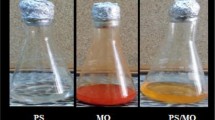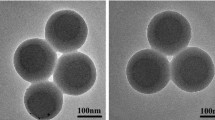Abstract
Luminescent polystyrene microspheres were easily fabricated from poly (styrene-co-methacrylic acid) and aqueous RE(III) chloride solution (RE=Eu, Tb) in the presence of 2,2′-bipyridine as second ligand. The negative charges of carboxyl groups on the surface of microspheres coordinated with rare earth ions at first, such as complexes covalently linked to 2,2′-bipyridine, resulting in strong photoluminescence. Various methods, including transmission electron microscope (TEM), scanning electron microscope (SEM), energy dispersive spectroscopy (EDS), Fourier transform infrared spectroscopy (FT-IR), and fluorescence spectrophotometer, were used to characterize the resultant polystyrene composite microspheres. This work highlights the idea that it is facile to synthesis luminescent microspheres by surface-modified method directly.





Similar content being viewed by others
References
Binnemans K. Lanthanide-based luminescent hybrid materials. Chem Rev. 2009;109(9):4283.
Li M, Zhang P, Li J, Zhou J, Sinitskii A, Abramova V, Klimonsky SO, Tretyakov YD. Directional emission from rare earth ions in inverse photonic crystals. Appl Phys B. 2007;89(2–3):251.
Pietraszkiewicz M, Mal S, Pietraszkiewicz O. Novel, highly photoluminescent Eu(III) and Tb(III) tetrazolate-2-pyridine-1-oxide complexes. Opt Mater. 2012;34(9):1507.
Buenzli J-CG. Lanthanide luminescence for biomedical analyses and imaging. Chem Rev. 2010;110(5):2729.
Elbanowski M, M
 kowska B. The lanthanides as luminescent probes in investigations of biochemical systems. J Photochem Photobiol A. 1996;99(2–3):85.
kowska B. The lanthanides as luminescent probes in investigations of biochemical systems. J Photochem Photobiol A. 1996;99(2–3):85.Huhtinen P, Kivela M, Kuronen O, Hagren V, Takalo H, Tenhu H, Lovgren T, Harma H. Synthesis, characterization, and application of Eu(III), Tb(III), Sm(III), and Dy(III) lanthanide chelate nanoparticle labels. Anal Chem. 2005;77(8):2643.
Huhtinen P, Kivela M, Soukka T, Tenhu H, Lovgren T, Harma H. Preparation, characterisation and application of europium(III) chelate-dyed polystyrene-acrylic acid nanoparticle labels. Anal Chim Acta. 2008;630(2):211.
Li Q, Li T, Wu J. Luminescence of europium(III) and terbium(III) complexes incorporated in poly(vinyl pyrrolidone) matrix. J Phys Chem B. 2001;105(49):12293.
Yan B, Zhang H, Wang S, Ni J. Luminescence properties of rare-earth (Eu3+ and Tb3+) complexes with paraaminobenzoic acid and 1,10-phenanthroline incorporated into a silica matrix by sol–gel method. Mater Res Bull. 1998;33(10):1517.
Lee CI, Lim JS, Kim SH, Suh DH. Synthesis and luminescent properties of a novel Eu-containing nanoparticle. Polymer. 2006;47(15):5253.
Li XH, Yang TL, Huo LN. Synthesis, characterization of chiral Eu(III) complexes and study of chiral fluorescence probe to ct-DNA. Chin J Rare Met. 2013;37(1):97.
Flores M, Caldino U, Cordoba G, Arroyo R. Luminescence enhancement of Eu3+-doped poly(acrylic acid) using 1,10-phenanthroline as antenna ligand. Opt Mater. 2004;27(3):635.
Ye YX, Wei LH, Sheng WC, Chen M, Hua YQ. Luminescent properties of a new Nd3+-doped complex with two different carboxylic acids and pyridine derivative. Rare Met. 2013;32(5):490.
Sheng K, Yan B, Qiao XF, Guo L. Rare earth (Eu/Tb)/phthalic acid functionalized inorganic Si-O/organic polymeric hybrids: chemically bonded fabrication and photophysical property. J Photochem Photobiol A. 2010;210(1):36.
Latva M, Takalo H, Mukkala V-M, Matachescu C, Rodríguez-Ubis JC, Kankare J. Correlation between the lowest triplet state energy level of the ligand and lanthanide(III) luminescence quantum yield. J Lumin. 1997;75(2):149.
Yu XJ, Su QD. Photoacoustic and luminescence properties study on energy transfer and relaxation processes of Tb(III) complexes with benzoic acid. J Photochem Photobiol A. 2003;155(1–3):73.
Acknowledgments
This work was financially supported by the National Natural Science Fundation of China (No.50873085).
Author information
Authors and Affiliations
Corresponding authors
Rights and permissions
About this article
Cite this article
Ma, ZX., Zhang, QT., Liu, JL. et al. Preparation of luminescent polystyrene microspheres via surface-modified route with rare earth (Eu3+ and Tb3+) complexes linked to 2,2′-bipyridine. Rare Met. 34, 590–594 (2015). https://doi.org/10.1007/s12598-014-0263-x
Received:
Revised:
Accepted:
Published:
Issue Date:
DOI: https://doi.org/10.1007/s12598-014-0263-x





 kowska B. The lanthanides as luminescent probes in investigations of biochemical systems. J Photochem Photobiol A. 1996;99(2–3):85.
kowska B. The lanthanides as luminescent probes in investigations of biochemical systems. J Photochem Photobiol A. 1996;99(2–3):85.